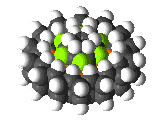Introduction of various types of fullerenes and Bucky Ball buildings in (CNTs, Nanotubes Carbon) based on nano-microelectronics PHD (educational-research doctorate)
Researcher and author PhD student: Afshin Rashid
Note: Nanofluorines have the ability to store electrostatic energy, which can be used as a very high capacity capacitive nanoparticle. These nanotubes can also repair the neural network . Carbon nanofluorescents are carbon allotropes such as diamonds and graphite. These compounds are made of carbon, in which spherical, elliptical shapes are called spherical wings.
Fleurins do not have much chemical activity. The width of the graphite plate is about a few nanometers. The length of the nanotubes is in the range of a few micrometers to less than one meter. Their unique molecular structure creates unusual macroscopic properties.
Non-carbon nanofluids
In non-carbonic fluorines, other elements form a structure similar to that of fluorines, the chemical structure of which is often a metal oxide, with vanadium oxide being an example.
Intrauterine fullerenes
They enclose various atoms, and the nanostructures obtained are used for applications such as trace elements and biological processes.
Multilayer Florines
Multi-layered fullerenes include several fullerenes that are located inside each other. For this reason, this structure is also called nano-onion .
Fleurins are sensitive to light, and their electrical properties change dramatically as the wavelength of light changes. Such as: organic luminous diodes with long life and high performance and inside the molecules of fullerene can be filled by other elements. For example, by placing some metal elements inside the fullerenes, their electrical properties can be improved. The fluorine molecule can also be used to store nanoparticles and non-carbon atoms .
Conclusion:
Carbon nanotubes are referred to as stretched fullerenes. Graphene plates are used to empower carbon nanotubes. Nano-fullerenes with the ability to store electrostatic energy that can be used as a very high capacitive nanoparticle.
Author: PhD Student ( Afshin Rashid)




